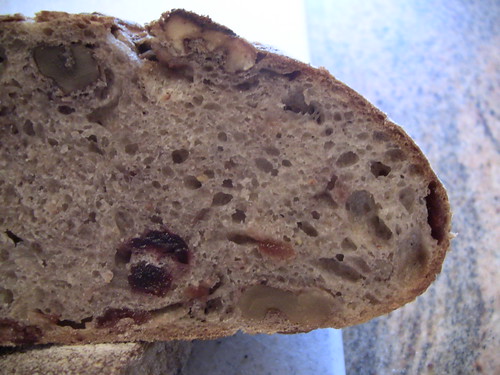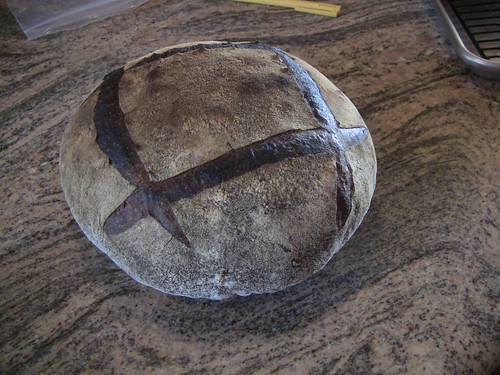
Tartine Basic Country Bread and SFBI Walnut-Currant Bread
We had guests this weekend, and they’re bread lovers. So the bread sort of became the centerpiece of the weekend.
Friday night I made the two very different levains, one for Tartine Basic Country Bread (50% whole wheat and 50% white at 100% hydration) and one for the SFBI Walnut-Currant Bread (95% white and 5% rye at about 55% hydration). The Walnut-Currant bread is my variation on the Walnut-Raisin Bread Brother David posted about last December (http://www.thefreshloaf.com/node/21289/walnut-raisin-sourdough-bread-sfbi-artisan-ii).
Saturday morning I mixed both doughs fairly early. The timing worked well, since the Walnut-Currant bread has shorter primary ferment time and shorter proofing time. Because I knew we’d eat a lot of it, and because I wanted to continue my experiments with loaf size, I made two full size (975 gram) loaves of the BCB and retarded one in the 50 F garage to bake the two sequentially (previous experience having shown that two slack loaves of that size don’t really fit on my stone).
I made the Walnut-Cranberry breads—two 550 gram boules—with about 10% pumpernickel flour, which gave it a slightly deeper, richer flavor. This bread made a very nice appetizer before dinner Saturday and was wonderful toasted for breakfast with cream cheese.
The two Tartine loaves ended up looking quite different from each other. The first one was browning too fast, and I covered the top with aluminum foil and reduced the temperature to around 450 F (with convection) for the second half of the bake. Attempting to reduce the char, I baked the second one—the one proofed more slowly at lower temperature—at 475 F with steam for 20 minutes and at 450F (with convection) without steam for about 17 minutes more. The second one had a nicer crust color and better grigne, and slightly more upward expansion. The two loaves' crumb texture and taste are almost identical. That is to say, delicious!
BCB Crumb
For dinner Saturday, I wanted to serve something that would compliment the Basic Country Bread. I settled on a Daube a l'Agneau (lamb stew in a Provencal style), marinated 15 hours in wine, cognac, herbs, spices and vegetables and then braised slowly for four hours. Nothing could have made better gravy to sponge up with this wonderful bread. Delicious with a well-aged Oregon Pinot Noir.
I continue to be very happy with the crumb texture of this Tartine bread, but I think next time I bake it I’ll go back to the Dutch Oven method. In my four or five bakes of this bread, that method resulted in the best crust color and grigne.
Glenn







Comments
before I could congratulate you on an outstanding bake and a fabulous menu. Good stuff, Glenn!
Paul
The Daube and the bread were both even better the next day.
Glenn